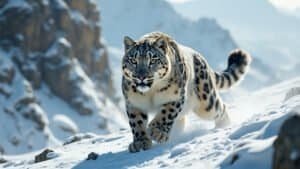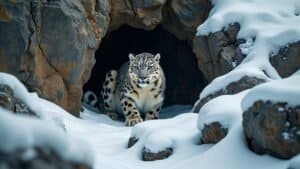Introduction
Snow leopards, known for their elusive nature and majestic presence in rugged mountainous regions, exhibit unique social structures
This article explores various aspects of their social behavior, including how they establish and maintain territories, methods of communication, social interactions, and the influence of the environment on their behavior
Additionally, we will discuss the challenges researchers face in studying these magnificent creatures and the conservation efforts to protect them. Dive in to understand the fascinating world of snow leopards and their social dynamics
Territoriality and Home Range
Snow leopards are known for their solitary and elusive nature, primarily occupying the high-altitude regions of Central Asia. Understanding their territorial behavior is crucial for conservation efforts, as it impacts their interaction with each other and their environment
This section will delve into how snow leopards establish and maintain territories, the sizes of their home ranges, and the role of scent marking in their social structures
Establishing Territories
Snow leopards establish their territories through a combination of scent marking, vocalizations, and visual signals. These methods serve to communicate presence and boundaries to other snow leopards, reducing the likelihood of direct confrontations
Scent marking, which involves urine, feces, and glandular secretions, is the most common method. They deposit these markers along well-traveled routes, such as ridgelines and valley bottoms, to signal their presence
A study conducted by the Snow Leopard Trust found that male snow leopards have larger territories than females, often overlapping with several female territories
This overlap allows males to maximize their mating opportunities while maintaining exclusive access to resources within their core areas. Females, on the other hand, establish territories that provide sufficient resources to raise their cubs, ensuring their survival
Home Range Sizes
The home range size of a snow leopard varies significantly depending on the availability of prey and the quality of habitat
On average, snow leopards have home ranges spanning 12 to 39 square miles, though some ranges can extend up to 77 square miles in areas with sparse prey. Males typically have larger home ranges compared to females, reflecting their need to access multiple female territories
Research by McCarthy et al. (2005) highlighted that in regions like Mongolia, where prey density is low, snow leopards need to cover larger areas to meet their dietary needs
Conversely, in regions with higher prey density, such as parts of Bhutan, their home ranges are more compact. This adaptability in home range size underscores the snow leopard’s resilience in diverse environments but also highlights the challenges they face in areas with declining prey populations
Scent Marking
Scent marking plays a pivotal role in snow leopard social structures, functioning as both a communication tool and a territorial marker
By marking their territory with scent, snow leopards convey information about their identity, reproductive status, and territorial boundaries to other individuals. This reduces the likelihood of physical encounters, which can be costly in terms of energy and injury risk
Studies have shown that snow leopards have specific scent-marking sites, often located along ridgelines, cliff bases, and other prominent landscape features
These sites are visited frequently, with snow leopards renewing their scent marks to maintain their presence in the area. Additionally, scent marking helps snow leopards keep track of their neighbors’ movements and reproductive status, facilitating breeding opportunities and minimizing conflicts
The effectiveness of scent marking is evident in the low frequency of direct confrontations between snow leopards. While they are solitary animals, the information conveyed through scent marks allows them to coexist in overlapping territories without frequent aggressive interactions
Communication Methods
Snow leopards, while predominantly solitary, have developed sophisticated methods of communication to interact with each other
These methods include vocalizations, visual signals, and scent communication, each playing a crucial role in their social structure. Understanding these communication methods provides insight into how snow leopards maintain social cohesion and avoid conflicts
Vocalizations
Snow leopards are known to produce a variety of vocalizations, each serving a different purpose. These vocal sounds include growls, hisses, and purrs, which are typically used in close-range communication
However, the most distinctive vocalization of snow leopards is the “chuffing” sound, a non-aggressive greeting noise that helps maintain social bonds between individuals
A study by the Snow Leopard Conservancy revealed that chuffing is often observed between mothers and their cubs, as well as between mating pairs. This sound helps to reassure and bond individuals, playing a vital role in nurturing relationships within the sparse population
Additionally, males use loud vocalizations during the mating season to attract females and establish dominance over other males in the area
Visual Signals
Visual signals are another important aspect of snow leopard communication. These signals include body postures, facial expressions, and tail movements. For instance, a snow leopard arching its back and puffing up its fur is a display of aggression or defensive behavior, intended to deter potential threats
Facial expressions, such as baring teeth or flattening ears, also convey different emotions and intentions. These visual cues are essential during encounters between snow leopards, helping them interpret each other’s moods and intentions without resorting to physical confrontations
Tail movements, particularly the positioning and flicking of the tail, are used to signal various states of alertness or agitation. A snow leopard with an erect and slowly moving tail is usually relaxed, while rapid tail flicking can indicate irritation or readiness to act
Scent Communication
Scent communication is perhaps the most critical method of interaction among snow leopards. Through scent marking, these big cats leave olfactory messages that convey a wealth of information. The main types of scent marks include urine spraying, feces deposition, and glandular secretions
Research by Janecka et al. (2017) highlighted that snow leopards have a well-developed vomeronasal organ (VNO), which allows them to detect and interpret pheromones present in scent marks
This organ is essential for understanding reproductive status, territorial boundaries, and individual identities. The VNO’s role in scent detection underscores the importance of chemical communication in snow leopard social structures
Scent marking sites are often revisited and refreshed, ensuring that the information remains current. These sites serve as communal “bulletin boards,” where snow leopards can keep track of each other’s movements and activities. The frequent use of these sites indicates their significance in maintaining social order and facilitating mating opportunities
Social Interactions and Bonds
Despite their reputation for being solitary, snow leopards exhibit a variety of social interactions and bonds, particularly during mating season and between mothers and their cubs
This section explores the solitary nature of snow leopards, their mating behaviors, and the relationships between mothers and their offspring
Solitary Nature
Snow leopards are primarily solitary animals, with each individual maintaining its own territory
This solitary lifestyle is largely a result of the harsh environments they inhabit, where resources such as prey are often scarce. By living alone, snow leopards can maximize their access to these limited resources, ensuring their survival
However, this does not mean that snow leopards are completely antisocial. They do interact with each other, particularly during the breeding season and when mothers are raising their cubs. These interactions are essential for reproduction and the continuation of the species
Mating Behaviors
The mating season for snow leopards typically occurs between January and March
During this time, males and females come together, temporarily breaking their solitary habits. Males will roam over larger areas to locate females in estrus, often using scent marks to communicate their presence and reproductive readiness
Once a male finds a receptive female, the two engage in a courtship that includes vocalizations, chuffing, and physical contact. Mating itself is brief but may occur multiple times over several days. After mating, the male usually departs, leaving the female to gestate and raise the cubs alone
A study by Johansson et al. (2016) found that snow leopard cubs are typically born between April and June, after a gestation period of around 90-100 days. Females give birth to litters of one to three cubs in secluded dens, often located in rocky crevices or caves
These dens provide protection from predators and harsh weather conditions
Mother-Cub Relationships
The bond between a snow leopard mother and her cubs is one of the few enduring social relationships in the species. Mothers are solely responsible for the care and upbringing of their cubs, teaching them essential survival skills such as hunting and navigating their rugged habitat
Cubs remain with their mother for about 18-22 months, during which time they learn to identify prey, stalk, and execute a hunt. This period is crucial for their development, as the skills they acquire determine their chances of survival once they become independent
Research conducted by the Snow Leopard Trust observed that mother snow leopards are highly protective of their cubs, often relocating them to new dens to avoid detection by potential threats. The constant care and attention provided by the mother ensure that the cubs are well-prepared for the challenges of solitary life
While the mother-cub bond is strong, it eventually dissolves as the cubs reach maturity. Young snow leopards must then establish their own territories and begin their solitary lives. The separation is gradual, with cubs starting to venture out on their own before fully leaving their mother’s side
Environmental Influences
The environment plays a significant role in shaping the social structures and behaviors of snow leopards. Factors such as habitat, prey availability, and human encroachment impact how these elusive cats interact with their surroundings and each other
This section examines the influence of these environmental factors on snow leopard behavior and social organization
Habitat and Territory
Snow leopards are adapted to live in the rugged, mountainous regions of Central Asia, including the Himalayas, the Tibetan Plateau, and the Altai Mountains. These habitats are characterized by steep terrain, rocky outcrops, and sparse vegetation, providing the perfect camouflage for these elusive predators
The harsh and challenging environment of their habitat influences snow leopard behavior significantly
The need to navigate steep cliffs and rocky terrain means that snow leopards have developed exceptional agility and strength. Their large home ranges, often spanning 12 to 39 square miles, are necessary to ensure they can find sufficient prey and avoid direct competition with other snow leopards
A study by the World Wildlife Fund (WWF) indicates that snow leopards prefer elevations between 9,800 and 16,400 feet, where their primary prey, such as blue sheep and ibex, are found. These elevations also provide natural barriers that help delineate territories and reduce the likelihood of encounters with other snow leopards
Impact of Prey Availability
Prey availability is a critical factor influencing snow leopard social structures. In regions where prey is abundant, snow leopards can maintain smaller home ranges, reducing the need for extensive travel and interactions with other individuals
Conversely, in areas with low prey density, snow leopards must cover larger territories to meet their dietary needs, increasing the potential for territorial overlap and interactions
Research by Lovari et al. (2013) demonstrated that in areas with higher prey density, such as parts of Bhutan, snow leopards have smaller and more defined territories. This leads to less frequent territorial disputes and more stable social structures. In contrast, in regions like Mongolia, where prey is scarcer, snow leopards have larger home ranges and more fluid territorial boundaries
The availability of prey also affects the reproductive success of snow leopards. Females require sufficient prey resources to raise their cubs successfully. During periods of prey scarcity, cub mortality rates increase, and females may not reproduce every year, impacting the overall population dynamics
Human Encroachment
Human encroachment poses a significant threat to snow leopard populations and their social structures. Habitat loss due to infrastructure development, mining, and agricultural expansion forces snow leopards into smaller, fragmented territories, increasing the likelihood of human-wildlife conflicts
Snow leopards often prey on livestock, leading to retaliatory killings by local herders. These conflicts not only reduce snow leopard numbers but also disrupt their social structures by removing individuals from the population
Conservation efforts, such as community-based livestock insurance programs and improved livestock management practices, are essential to mitigate these conflicts and protect snow leopard habitats
Additionally, climate change is altering the snow leopards’ habitat, pushing them to higher elevations where prey may be less abundant. This shift further strains their social structures and survival, emphasizing the need for comprehensive conservation strategies that address both environmental and human-induced challenges
Challenges in Studying Social Structures
Studying the social structures of snow leopards presents numerous challenges due to their elusive nature and the harsh environments they inhabit. Researchers face difficulties in accessing remote habitats, tracking these solitary animals, and gathering sufficient data to understand their behaviors
This section delves into these challenges and the efforts made to overcome them
Remote Habitats
Snow leopards live in some of the most inaccessible regions of the world, including the Himalayas, the Tibetan Plateau, and the mountainous areas of Central Asia. These areas are characterized by extreme altitudes, rugged terrain, and harsh weather conditions, making field research physically demanding and logistically complex
The remoteness of snow leopard habitats means that researchers often have to trek for days to reach study sites, carrying all necessary supplies and equipment. This limits the duration and frequency of field studies, constraining the amount of data that can be collected
A report by the International Union for Conservation of Nature (IUCN) highlights that the logistical challenges of working in these environments also increase the cost of research. Funding constraints often limit the scope and duration of studies, impacting the overall understanding of snow leopard social structures
Elusive Nature
Snow leopards are inherently elusive and solitary animals, primarily active during dawn and dusk (crepuscular) or nighttime (nocturnal)
Their excellent camouflage and preference for rugged terrain make direct observations rare and difficult. These characteristics pose significant challenges for researchers trying to study their behaviors and interactions
Traditional methods of wildlife observation, such as direct sightings, are largely ineffective for snow leopards. Researchers have had to rely on indirect methods, such as tracking spoor (footprints) and scat (droppings), to infer their presence and behavior. While these methods provide valuable insights, they are often labor-intensive and time-consuming
Conservation Efforts
Despite these challenges, advances in technology have provided new tools for studying snow leopards. Camera traps, for example, have revolutionized wildlife research by capturing images and videos of these elusive cats in their natural habitats
These devices, equipped with motion sensors, can operate continuously for months, providing a wealth of data on snow leopard activity, territoriality, and interactions
A study by Kachel et al. (2017) demonstrated the effectiveness of camera traps in identifying individual snow leopards based on their unique spot patterns. This technology has enabled researchers to estimate population densities, monitor reproductive success, and track changes in snow leopard populations over time
Additionally, GPS collars have been instrumental in tracking the movements and behaviors of snow leopards. These collars provide precise location data, allowing researchers to map home ranges, study territorial overlaps, and understand habitat use
However, capturing and collaring snow leopards is a complex and costly process, requiring significant expertise and resources
Conservation organizations, such as the Snow Leopard Trust and Panthera, have been at the forefront of efforts to study and protect snow leopards. These organizations collaborate with local communities, governments, and other stakeholders to implement conservation programs, conduct research, and raise awareness about the importance of protecting snow leopard habitats
Conclusion
In exploring the social structures of snow leopards, we have uncovered a complex interplay of solitary behaviors, territoriality, and subtle social interactions
These majestic creatures, adapted to some of the most extreme environments on Earth, maintain large territories marked by sophisticated communication methods, such as scent marking and vocalizations. Despite their solitary nature, snow leopards exhibit important social bonds, especially between mothers and cubs and during the mating season
Their environment plays a crucial role in shaping their behaviors, with habitat characteristics, prey availability, and human encroachment significantly influencing their social dynamics. Studying these elusive animals presents numerous challenges, but advances in technology and dedicated conservation efforts are helping researchers gain deeper insights into their lives
Understanding the social structures of snow leopards is vital for their conservation. As we continue to uncover the mysteries of these elusive big cats, our knowledge will inform more effective strategies to protect and preserve snow leopard populations for future generations













